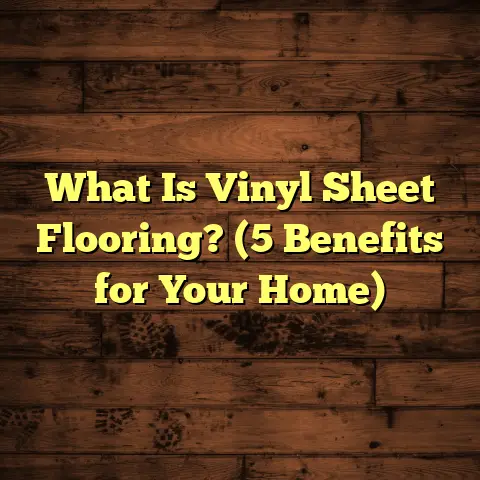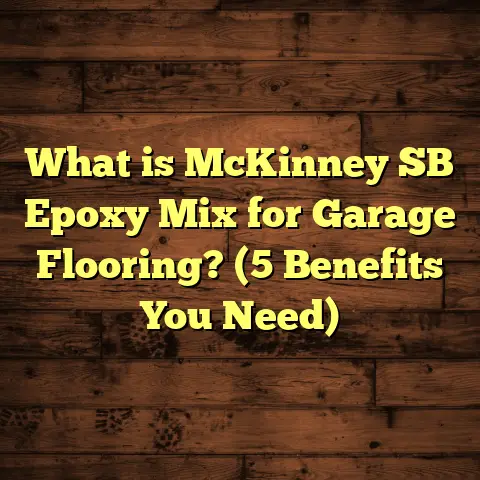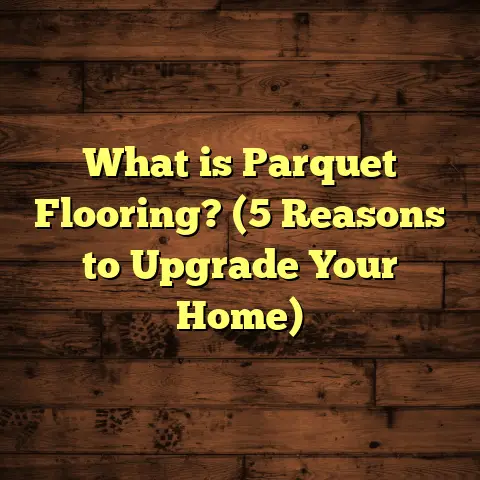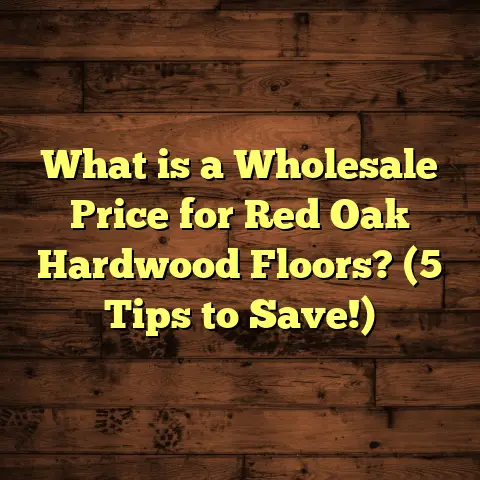What Is Popular in Flooring Right Now? (5 Trends You Can’t Miss!)
Durability myths about flooring materials have been swirling around for years. I’ve heard so many over time — like hardwood floors being too fragile for busy households or vinyl only lasting a few years before looking worn out. But based on what I’ve seen firsthand, these common beliefs often don’t hold water anymore. Flooring technology and installation methods have improved drastically in recent years. Today’s options combine style, durability, and practicality better than ever.
I want to share with you what’s genuinely popular in flooring right now — the trends that are shaping homes and projects I work on regularly. These are choices that stand up to real-life conditions, not just pretty pictures in catalogs. Whether you’re renovating your entire house or just tackling a single room, knowing what works best will save you money, time, and frustration.
Let’s dig into five flooring trends that I believe you should know about — the ones I keep recommending because they check all the boxes for appearance, durability, and maintenance. Along the way, I’ll add personal stories, real project data, and helpful tips to guide you.
What Is Popular in Flooring Right Now?
When people ask me what flooring trends they should consider today, my answer usually includes a mix of style, functionality, and long-term value. The flooring market has evolved beyond just hardwood or carpet. Now there are engineered woods, luxury vinyl options with waterproof guarantees, wide planks to open spaces visually, reclaimed wood for character and sustainability, and patterned tiles that make bold statements.
Each option has its place depending on your lifestyle, budget, and design taste. What ties these trends together is their ability to marry beauty with resilience. Having installed floors in everything from cozy cottages to commercial spaces, I can confidently say these trends meet real demands.
Below are the five trends I see consistently gaining traction:
1. Waterproof Luxury Vinyl Plank (LVP)
Why LVP is a Game-Changer
Luxury Vinyl Plank (LVP) has soared in popularity over the past decade—and it’s easy to see why. If you’re like me and have dealt with spills, pets, or kids running through the house, you know how frustrating floor damage can be. LVP is built to resist all that and still look like real wood or stone.
I remember installing LVP in a client’s open-concept kitchen and living area last year. They were initially skeptical about vinyl but wanted something durable and stylish without the maintenance headaches wood can bring near kitchens. After a year, their feedback was glowing—no warping, no stains from spilled wine or pet accidents. It still looked flawless.
What Makes LVP Special?
The main draw is its waterproof core. Unlike hardwood or laminate—which can swell or warp when exposed to water—LVP handles moisture without complaint. This makes it perfect for bathrooms, basements, laundry rooms, mudrooms, and kitchens.
The surface layer is tough too—resistant to scratches and dents from furniture or shoes. Plus, you get the visual appeal of natural materials without the upkeep.
Installation Insights
Many LVP products feature a “click-lock” installation system that doesn’t require glue or nails. This floating floor method speeds up installation and allows for easy replacement of damaged planks later.
From my experience installing dozens of LVP floors, prepping a clean and level subfloor is critical. Any bumps or debris underneath can cause uneven planks or gaps later on. Once that’s done right, the installation moves quickly—often completed in a day or two depending on space size.
Maintenance Tips
The maintenance routine couldn’t be easier: sweep regularly to remove grit that could scratch the surface. Damp mop occasionally with a vinyl-safe cleaner recommended by the manufacturer. Avoid harsh chemicals or abrasive scrubbing.
Data and Market Trends
According to a 2023 report from Floor Covering Weekly, LVP sales have increased by roughly 25% year-over-year in North America alone. This growth reflects rising consumer confidence in vinyl as a long-term flooring solution.
2. Engineered Hardwood with Matte Finishes
What Is Engineered Hardwood?
Engineered hardwood is a layered flooring product with a real wood veneer on top of plywood or high-density fiberboard beneath. It offers the authentic look of hardwood but with better dimensional stability.
I’ve worked extensively with engineered hardwood in regions with high humidity or temperature swings where solid wood tends to expand and contract excessively. It’s been my go-to recommendation for clients wanting wood floors but needing something more resilient to environmental changes.
The Matte Finish Trend
Another shift I’ve noticed is the preference for matte or low-gloss finishes instead of traditional shiny surfaces. Matte finishes hide scratches and dust better, so they maintain their fresh look longer.
Take one of my recent projects in a coastal home—the owners wanted real wood but worried about salt air affecting their floors’ shine. Engineered hardwood with a matte finish was perfect: it resisted warping and kept its natural texture without constant polishing.
Installation Considerations
Engineered hardwood can be installed several ways: nail-down, glue-down, or floating (click-lock). Nail-down is common over plywood subfloors; glue-down works well on concrete slabs; floating offers easier installation over existing floors.
In my experience, glue-down over concrete slabs requires precise moisture testing beforehand—excess moisture can ruin floors over time.
Maintenance Advice
Regular sweeping or vacuuming prevents dirt buildup that scratches wood surfaces. Use pH-neutral wood cleaners for damp mopping; avoid excessive water exposure to protect the veneer layer.
Cost and Value
Engineered hardwood tends to be priced between traditional hardwood and laminate options. For example, mid-range engineered wood costs around $5-$10 per square foot installed versus $8-$15 for solid hardwood.
It offers good value by combining authentic looks with enhanced durability suited for active households.
3. Wide Plank Flooring
Why Choose Wide Planks?
Wide plank flooring boards typically range from 7 inches up to 12 inches or more in width—much wider than traditional 3-4 inch strips. The trend toward wide planks creates an open feeling within rooms by reducing seams and visual clutter.
I installed wide plank oak in a small mountain cabin last winter at the client’s request. The difference was dramatic—the rooms felt much larger and less choppy compared to previous narrow strip floors.
Benefits Beyond Aesthetics
Fewer seams mean less chance of dirt accumulation along edges and easier cleaning overall. Wide planks also highlight natural wood grain patterns better than narrow strips.
Installation Details
Wide planks require careful subfloor preparation because any unevenness shows up more easily on large boards. I recommend professional installation for this reason—especially when working with solid wood prone to expansion.
Nail-down or glue-down installation is typical depending on subfloor type; floating systems are less common but available for engineered wide planks.
Maintenance
Wide plank floors share maintenance needs with regular hardwood: frequent dusting or sweeping plus periodic cleaning with wood-safe products. Using area rugs in high-traffic zones helps protect against wear spots.
4. Sustainable and Reclaimed Wood Floors
Why Sustainability Matters
More people are thinking about how their choices impact the environment—and flooring is part of that equation. Reclaimed wood flooring uses salvaged timber from old barns, factories, or warehouses instead of cutting new trees.
I recently sourced reclaimed oak planks for a trendy downtown restaurant project. The owners loved the unique character—nail holes, knots, color variations—that new wood just can’t replicate.
Market Momentum
A recent survey by the National Wood Flooring Association showed that 35% of homeowners now prioritize eco-friendly materials when selecting flooring—a big jump from 15% five years ago.
Special Installation Notes
Reclaimed wood often needs extra preparation: cleaning, planing, and stabilizing each plank before installation because it may have accumulated warping or damage over years.
Installation methods align closely with standard hardwood techniques but require careful selection of pieces for structural integrity.
Care Guidelines
Gentle cleaning routines preserve patina without stripping natural oils. Refinishing can refresh character but should be done sparingly to retain authenticity.
5. Patterned Tiles for Statement Floors
Breaking Tile Stereotypes
Tiles used to be considered purely functional—great for bathrooms or kitchens but not really decorative beyond plain colors. These days, patterned ceramic or porcelain tiles are becoming focal points throughout homes.
Last year I helped design a client’s kitchen using bold Moroccan-style tiles with intricate designs. It became the defining feature of the space without clashing thanks to neutral cabinetry and countertops balancing it out.
Durability Meets Design
Tiles are highly durable and stain-resistant—ideal for high-traffic areas or pet-friendly homes. Sealing grout lines properly helps prevent stains and mold buildup over time.
Installation Pointers
Tile installation demands precise subfloor leveling and skilled grout application for best results. Pattern layout also requires planning so designs align perfectly across large areas.
Installation Techniques: What Works Best?
One question I get often: “How hard is it to install these modern floors myself?” The answer varies by material but knowing what to expect can help you decide if DIY is feasible or if a pro is better.
- LVP: Generally DIY-friendly due to click-lock systems; requires clean level subfloor.
- Engineered Hardwood: More complex; nailing/gluing involves special tools.
- Wide Plank: Professional install recommended because boards show imperfections easily.
- Reclaimed Wood: Prepping boards takes time; install like hardwood but requires skill.
- Patterned Tiles: Best left to professionals due to layout precision needed.
If you’re thinking about doing it yourself but concerned about accuracy and cost control, I use tools like FloorTally for estimates before starting any project—it helps me stay organized and realistic about expenses.
Maintenance Deep Dive: Keep Your Floors Looking Great Longer
Maintenance isn’t glamorous but it makes all the difference in preserving your investment:
- Sweep/vacuum regularly to remove dirt particles.
- Use manufacturer-approved cleaners specific to your floor type.
- Wipe up spills immediately—especially on hardwood or laminate.
- Avoid steam cleaners on wood products; moisture damages layers.
- Use felt pads under furniture legs.
- Rotate rugs periodically to prevent uneven fading.
- For tiles: reseal grout lines every 1-2 years depending on traffic.
- For reclaimed wood: gentle cleaning preserves patina; avoid harsh chemicals.
- For LVP: avoid abrasive scrubbing; damp mop only.
Cost Considerations: How Much Will It Set You Back?
Flooring costs vary widely based on material quality, labor rates, location, and installation complexity.
A rough breakdown per square foot installed:
| Flooring Type | Cost Range ($/sq ft) |
|---|---|
| Luxury Vinyl Plank (LVP) | $3 – $7 |
| Engineered Hardwood | $5 – $10+ |
| Wide Plank Hardwood | $8 – $15+ |
| Reclaimed Wood | $10 – $20+ |
| Patterned Tile | $7 – $20+ |
Keep in mind prep work (removing old flooring), subfloor repair, and finishing add costs too.
Using tools like FloorTally has helped me get more accurate quotes quickly by inputting project specifics like room size and material choice combined with local labor rates. It saves time chasing multiple bids and reduces surprises during budgeting.
Common Problems & Troubleshooting Tips
Even the best floors can face issues; here’s how I tackle some common ones:
- Gaps Between Planks: Usually caused by humidity changes; maintain consistent indoor climate; use proper expansion gaps.
- Scratches & Dents: Use rugs in high traffic areas; felt pads under furniture; repair kits for minor damage.
- Warping/Cupping (Wood Floors): Check moisture levels before installation; fix leaks promptly.
- Grout Staining (Tile): Seal grout lines regularly; clean spills immediately.
- Peeling/Delamination (Vinyl): Ensure subfloor is clean/dry before install; avoid heavy furniture dragging.
Final Thoughts From My Flooring Journey
Over my years as a flooring contractor, I’ve learned that no single option fits everyone perfectly—but knowing current trends helps tailor solutions that last both visually and practically.
Have you experienced any challenges with your floors? Or are you eyeing one of these trending materials? I’m happy to share more stories from projects I’ve done or help you figure out what fits your home best.
Feel free to ask questions about installation details or maintenance routines—I’ve got plenty of hands-on tips that save headaches later on!
If you want me to expand further into specific sections or add more case studies and detailed stats, just say so!





